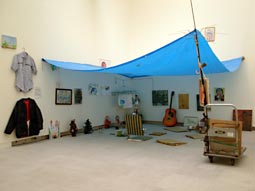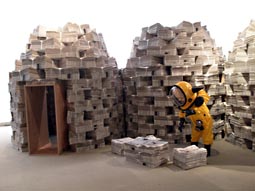 |
|
 |
Misako Ichimura / Tetsuo Ogawa,
Cafe ENOA RU Hiroshima (2008). |
|
Akira Suzuki, Houses of Newspaper (2008).
Foreground: Kenji Yanobe, Torayan (2004).
|
|
|
|
Taking the theme of shelters for survival in extreme conditions (natural disasters, war, homelessness, and so on), the current exhibition at the Hiroshima City Museum of Contemporary Art comprises work by seventeen artists, including some from the fields of architecture, fashion, and graphic design: Makoto Aida, Misako Ichimura and Tetsuo Ogawa, Hitoshi Ushijima, Tsuyoshi Ozawa, Lucy Orta and Jorge Orta, Kyohei Sakaguchi, Sancho Silva, Akira Suzuki, Noboru Tsubaki, Kosuke Tsumura, Shigeru Ban, Tatsumi Masuoka, MINE, Kaoru Motomiya, Yukinori Yanagi, Kenji Yanobe, and Michael Rakowitz. Some have created new pieces for the exhibition, while most have provided existing work.
There is an uncomfortable irony in viewing ideas about emergency housing within an art museum. Epitomized by Kyohei Sakaguchi's Zero Yen House, many of the pieces here are predicated on having scant material resources, or none at all. Yet as curator Takeshi Matsuoka notes, the very existence of fine art is predicated on surplus -- if not of material, then at least of time and energy. While many of the works lack any realistic application, others have been successfully put to the test (notably Shigeru Ban's Paper Log House), and some of the contributors actually dwell in the kind of environments they describe. Misako Ichimura and Tetsuo Ogawa's Cafe ENOA RU may appear to comprise little more than random trash gathered in a corner of the museum, but is in fact a reproduction of their lifestyle within a homeless colony in Tokyo's Yoyogi Park -- known as a "blue tent village" due to the distinctive blue plastic sheets used as shelter. Tsuyoshi Ozawa's Ivan the Fool House interposes these same blue sheets between sleeping units salvaged from a capsule hotel. Tatsumi Masuoka's spectacular Aluminum Can House was originally built adjacent to the blue-sheet shelter in which he lives, a celebration of personal creativity amid adversity. It is also pure excess: the resulting structure is unlivable in any season, and the cans themselves could have instead been traded for badly needed cash.
Some of the pieces use clothing as a minimum shelter, such as Kosuke Tsumura's FINAL HOME jackets, in which multiple zippers allow the linings to be stuffed with newspapers for insulation when sleeping outside. Kenji Yanobe's Torayan figurine reappears throughout the museum, dressed in a bright yellow radiation suit and carrying a Geiger counter. Indeed, intentionally or not, the theme of the exhibition has an unavoidable resonance with its location in Hiroshima. Hitoshi Ushijima has created a miniature of the A-Bomb Dome (the building that happened to be closest to the hypocenter of the blast on August 6, 1945, known since 1996 as the Hiroshima Peace Memorial). Noboru Tsubaki's Love Rebound comprises giant busts of the Japanese cartoon character Atom Boy and a generic crash-test dummy, both held within a metal frame the size of the cockpit of the Enola Gay (the plane that carried the bomb).
Even during peacetime, instant and unexpected homelessness is an ever-present danger in earthquake-prone Japan. Architecture critic Akira Suzuki has long promoted "building literacy" for the general public -- that is, the ability to build one's own shelter should the need arise -- and his contribution to the exhibition consists of igloo-like structures made from bales of newspaper and sheets of plywood. Like much of the work here, minimal means are used to create an aesthetic appeal beyond simple utility. Rem Koolhaas has elsewhere defined two broad types of minimalism: Zurich and Bombay. The former is sleek, sharp, neutral precision achieved at great expense, whereas the latter is messy, cheap, ad hoc improvisation. Arising from exigency rather than choice, much of the work on display here may be rough, but nonetheless admits a degree of dignity and delight to life in otherwise unbearable circumstances.
|